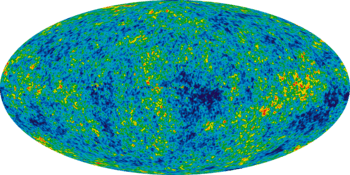Ecliptic alignment of CMB anisotropy
The Cosmic Microwave Background (CMB) radiation signature presents a direct large-scale view of the universe that can be used to identify whether our position or movement has any particular significance. There has been much publicity about analysis of results from the Wilkinson Microwave Anisotropy Probe (WMAP) and Planck mission that show both expected and unexpected anisotropies in the CMB.[1] The results appear to run counter to expectations from the Copernican Principle. The motion of the solar system, and the orientation of the plane of the ecliptic are aligned with features of the microwave sky, which on conventional thinking are caused by structure at the edge of the observable universe.[2][3]
Lawrence Krauss is quoted as follows in the referenced Edge.org article:[4]
"But when you look at CMB map, you also see that the structure that is observed, is in fact, in a weird way, correlated with the plane of the earth around the sun. Is this Copernicus coming back to haunt us? That's crazy. We're looking out at the whole universe. There's no way there should be a correlation of structure with our motion of the earth around the sun — the plane of the earth around the sun — the ecliptic. That would say we are truly the center of the universe."
Some anomalies in the background radiation have been reported which are aligned with the plane of the Solar System, which contradicts the Copernican principle by suggesting that the Solar System's alignment is special.[5] Land and Magueijo dubbed this alignment the "axis of evil" owing to the implications for current models of the cosmos,[6] although several later studies have shown systematic errors in the collection of that data and the way it is processed.[7][8][9] Various studies of the CMB anisotropy data either confirm the Copernican principle,[10] model the alignments in a non-homogeneous universe still consistent with the principle,[11] or attempt to explain them as local phenomena.[12] Some of these alternate explanations were discussed by Copi, et al., who claimed that data from the Planck satellite could shed significant light on whether the preferred direction and alignments were spurious.[13][14] Coincidence is a possible explanation. Chief scientist from WMAP, Charles L. Bennett suggested coincidence and human psychology were involved, "I do think there is a bit of a psychological effect, people want to find unusual things." [15] Data from the Planck Telescope published in 2013 has since found stronger evidence for the anisotropy. [16] "For a long time, part of the community was hoping that this would go away, but it hasn’t," says Dominik Schwarz of the University of Bielefeld in Germany. [17]
See also
References
- ↑ Anthony Challinor (2012). "CMB anisotropy science: A review". arXiv:1210.6008v1
 [astro-ph.CO].
[astro-ph.CO]. - ↑ CERN Courier "Does the motion of the solar system affect the microwave sky?"
- ↑ C. J. Copi; D. Huterer; D. J. Schwarz; G. D. Starkman (2006). "On the large-angle anomalies of the microwave sky". Monthly Notices of the Royal Astronomical Society. 367: 79–102. doi:10.1111/j.1365-2966.2005.09980.x. preprint
- ↑ "The Energy of Space That Isn't Zero."
- ↑ Mariano, Antonio; Perivolaropoulos, Leandros (2013). "CMB maximum temperature asymmetry axis: Alignment with other cosmic asymmetries". Physical Review D. 87 (4). doi:10.1103/PhysRevD.87.043511. ISSN 1550-7998.
- ↑ Land, Kate; João Magueijo, João (2005). "Examination of Evidence for a Preferred Axis in the Cosmic Radiation Anisotropy". Physical Review Letters. 95 (7). arXiv:astro-ph/0502237
 . Bibcode:2005PhRvL..95g1301L. doi:10.1103/PhysRevLett.95.071301.
. Bibcode:2005PhRvL..95g1301L. doi:10.1103/PhysRevLett.95.071301. - ↑ Liu, Hao; Li, Ti-Pei (2009). "Improved CMB Map from WMAP Data". arXiv:0907.2731v3
 [astro-ph].
[astro-ph]. - ↑ Sawangwit, Utane; Shanks, Tom (2010). "Lambda-CDM and the WMAP Power Spectrum Beam Profile Sensitivity". arXiv:1006.1270v1
 [astro-ph].
[astro-ph]. - ↑ Liu, Hao; et al. (2010). "Diagnosing Timing Error in WMAP Data". arXiv:1009.2701v1
 [astro-ph].
[astro-ph]. - ↑ Zhang, Pengjie; Stebbins, Albert (2011). "Confirmation of the Copernican Principle at Gpc Radial Scale and above from the Kinetic Sunyaev-Zel'dovich Effect Power Spectrum". Physical Review Letters. 107 (4). doi:10.1103/PhysRevLett.107.041301. ISSN 0031-9007.
- ↑ Buckley, Robert G.; Schlegel, Eric M. (2013). "CMB dipoles and other low-order multipoles in the quasispherical Szekeres model". Physical Review D. 87 (2). doi:10.1103/PhysRevD.87.023524. ISSN 1550-7998.
- ↑ Hansen, M; Kim, J; Frejsel, A.M; Ramazanov, S; Naselsky, P; Zhao, W; Burigana, C (2012). "Can residuals of the solar system foreground explain low multipole anomalies of the CMB?". Journal of Cosmology and Astroparticle Physics. 2012 (10): 059–059. doi:10.1088/1475-7516/2012/10/059. ISSN 1475-7516.
- ↑ Large-angle anomalies in the CMB
- ↑ The Uncorrelated Universe: Statistical Anisotropy and the Vanishing Angular Correlation Function in WMAP Years 1-3
- ↑ Found: Hawking's initials written into the universe
- ↑ Aghanim, N.; Armitage-Caplan, C.; et al. (2013). "Planck 2013 results. XXVII. Doppler boosting of the CMB: Eppur si muove". Astronomy & Astrophysics. 571 (27): A27. arXiv:1303.5087
 . Bibcode:2014A&A...571A..27P. doi:10.1051/0004-6361/201321556.
. Bibcode:2014A&A...571A..27P. doi:10.1051/0004-6361/201321556. - ↑ Michael Brooks (Apr 30, 2016). "That's odd: Axis of evil stretches across the cosmos". New Scientist.
